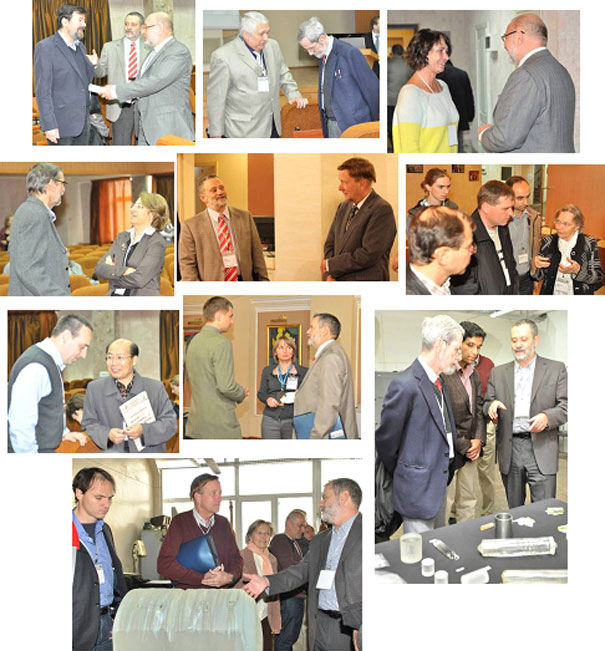| Home | ||
| About Project | ||
| Consortium | ||
| News | ||
| √ | Events | |
| Project activity | ||
| Virtual Lab | ||
| Useful links | ||
| Contact us | ||
 | ||
 | ||
 | ||
 | ||
SUCCESS project Executive SummaryDevelopments during the last decade have resulted in essential redistribution of key roles in the filed of radiation detection technologies. Significant investments of the USA administration to the Global Homeland Security Programme started in 2005, the considerable costs of Japanese government aimed at the elimination of the consequences from the Fukushima disaster (2011 – present time) have allowed USA and Asia to come to the foreground in the field of RDT. Europe is quickly losing its position in this type of activity. Despite great human resources, scientific and engineering potential, the most part of European research centres are essentially disintegrated and uncoordinated. From this point of view SUCCESS is a unique project aiming at consolidation of European research efforts in order to bring the radiation detection technology in Europe to the qualitatively new level by overcoming existing fragmentation, creation of a new physical model and approaches, developing tools and models able to match those of the USA and Asia. Ukraine is one of the Europe’s neighbors, and the reinforcement of the cooperation with Ukraine in the context of the European Research Area (ERA) is an important part of the European Union international collaboration activities. The 36-month SUCCESS project aiming at reinforcing the cooperation with Ukraine in Material sciences has been implemented by a EU-Ukrainian consortium composed of four partners - ISMA(UKR), UBCL (France), inno (France ) and Kharkov Technologies (UKR) - who have been supported by Scientific Reference Team of 3 world class scientists from Italy, Russia and Estonia. SUCCESS support action gave to Ukrainian and European research centers specialized in scintillators and luminescent material science the possibility to bring their research activities and relations on a new qualitative level through twinning activities between the Institute for Scintillation Materials of Academy of Science of Ukraine (ISMA), and its long term partner Laboratoire de phisico-chimie des materieux luminiscents, University Claude Bernard of Lyon (UCBL), France. The project activities supported a coherent plan for integrating ISMA into European Research Area, namely via full mapping of the ISMA capacities, extending of the cooperation with European research centers, and mobilizing stronger commitment to ISMA-UCBL collaboration. The project objectives have been fully achieved via the following activities:
International cooperation activities, such as networking & brokerage, ETP and FP7 consortia integration implemented on wide European and regional level, involving other European organisations to extend the project impact. ISMA participation in more than 30 international conferences, workshops and other sessions (hold in EU and in Ukraine) provided a supportive environment for promoting ISMA research capacities, partnership building and enlargement of cooperation between ISMA and European institutions in the field of ISMA interests. For integration in the EU consortiums ISMA has prepared 4 proposals and signed two memorandums of understanding on joint research with Polish and Armenian research centers. ISMA obtained a positive response to join the EuMaT – European Technology Platform for Advanced Engineering Materials and Technologies and it is expected that it will be a part of working group, namely in Nanomaterials, KMM materials and Materials for ICT.
Training and coaching activities significantly helped to build competences and to strengthen ISMA skills to integrate European research programs. SUCCESS project assisted to the training of ISMA and other Ukrainian research centers on FP7 and upcoming Horizon 2020’ mechanisms. More than 10 training sessions were delivered. Moreover ISMA and UCBL team organized a series of training session specifically dedicated to young specialists to become proficient in different scientific branches including scintillation physics, luminescent spectroscopy, material science and crystal growth. In term of figures, SUCCESS supported 10 short term researchers exchanges, 27 joint experiments using unique EU facilities involving young researchers, 5 Scientific workshops, SUCCESS International Conference on Advanced Scintillation Materials (90 participants), 150 publications, 13 networking and brokerage events, 2 memorandums of understanding, 12 management staff visits, two presentations on local TV. However, the realization of all these figures, that are largely beyond the initial targets, wouldn’t be possible without a strong commitment of partners to work together to promote the luminescence material sciences across Europe.
In sum, SUCCESS co-operation translated into concrete joint activities has demonstrated a high return on investment made by the European Commission not only in strengthening the bilateral scientific cooperation between the two leading scientific centers in Ukraine and in France, but also in improving the efficiency of European research in the field of radioluminescence, the detection of ionizing radiation, new scintillation materials, sensors and devices. Due to the effective twinning, Ukrainian and French research centers have confirmed and strengthened their respective competences aimed at innovative implementation of joint scientific projects in the field of space research, high-energy physics, medical diagnostics, ecology (ex. the control and prevention of unauthorized distribution of radionuclide). The project has played a significant role in the development of the ground for networking of the European research centres and shown a strategic interest for the European Union to create a single research area, which combines basic research, experimental development and production of luminescence materials and scintillators. The goal of the SUCCESS partners is to improve European research in the field of radiation detection technology by overcoming existing fragmentation of the research centres, creation of a new physical model and approaches. These structuring activities should begin NOW and via progress achieved through the SUCCESS CSA and other initiatives pushing forward the idea of creating a pan-EU community for EU competitiveness. Results of SUCCESS project are significant not only from scientific point of view – the most important outcome of SUCCESS lies in the consolidation and creation of the basis for future international scientific and technology collaboration between leading European research centres in Ukraine, Italy, Poland, Estonia.
|


